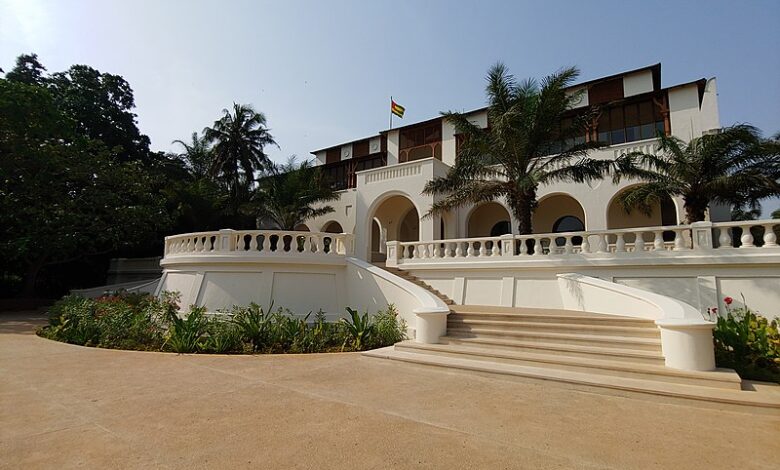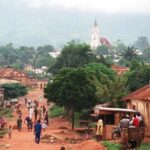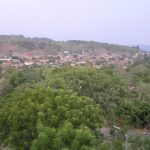Lomé

Lomé, a city with a unique blend of cultural heritage and modernity, is the vibrant capital and largest city of Togo. Nestled on the Gulf of Guinea, this bustling metropolis boasts a rich history, a thriving urban population of 837,437, and an expansive metropolitan area of 1,477,660 permanent residents as of the 2010 census. In this article, we’ll delve into the fascinating facets of Lomé, from its etymology and historical evolution to its economic significance, climate, and the looming challenges of climate change.
|
Location in Togo
|
|
| Coordinates: 6°7′55″N 1°13′22″E | |
| Country | |
|---|---|
| Region | Maritime Region |
| Prefecture | Golfe |
| Government
|
|
| • Mayor | Aouissi Lodé |
| Area
|
|
| • City | 99.14 km2 (38.28 sq mi) |
| • Metro
|
280 km2 (110 sq mi) |
| Elevation
|
10 m (30 ft) |
| Population
(2023 census)
|
|
| • City | 1,500,000 |
| • Density | 15,000/km2 (40,000/sq mi) |
| • Metro
|
2,000,000 |
| • Metro density | 7,150/km2 (18,500/sq mi) |
| Time zone | UTC |
Unveiling the Etymology of Lomé
The name ‘Lomé’ finds its roots in the Ewe language, where it translates to “in the alo trees” or “within the alo trees.” This name aptly refers to the forest of alo, a tree whose wood is traditionally used by the local population, particularly in the production of toothpicks. The forest of alo contributes not only to the city’s name but also to its cultural identity.
A Glimpse into the Historical Tapestry
Lomé’s history is a captivating narrative of growth and transformation. It was initially founded by the Ewes, a local ethnic group, and later, in the 19th century, became a hub for German, British, and African traders. The city’s strategic location, particularly its proximity to the British colony of Gold Coast, made it an ideal place for unloading goods, bypassing British customs duties. This commercial advantage spurred Lomé’s expansion, giving rise to a city where business thrived.
In the colonial era, Lomé’s significance continued to soar. The city’s role as an import center facilitated its rapid growth and led to the transfer of the Togoland capital in 1897. With the construction of critical infrastructure like the Lomé-Kpalimé road in 1892 and the establishment of a port in 1904, Lomé emerged as a vital economic nucleus in the region.
However, this economic prosperity also brought challenges, as discriminatory patents and licenses gradually excluded African traders from lucrative activities. The city’s unique blend of indigenous and European influences shaped its urban space and architecture, creating a distinctive character.
March Towards Independence
Lomé’s population surged in the mid-20th century, growing from 30,000 in 1950 to 200,000 in 1970. The city’s rapid development was marked by substantial investments in infrastructure, driven by the “FIDES” plan, which included roads, bridges, schools, and hospitals. However, the global economic crisis of the early 1930s had repercussions, leading to a recession and social unrest in the form of the riots of January 1933.
Lomé’s true economic resurgence occurred after the Second World War, with the city experiencing remarkable progress, characterized by extensive construction, employment opportunities, and infrastructure development.
Independence and Beyond
Togo gained independence in 1960, and Lomé continued to thrive. As the city expanded, it faced challenges in maintaining its urban infrastructure and managing the informal sector’s growth. The informal sector, comprised of various small-scale production, exchange, and service activities, became essential for the majority of the population’s livelihood.
Lomé’s unique urban landscape remains a testament to its diverse population and the contributions of its indigenous bourgeoisie. However, the city also grapples with issues related to waste management and urban sanitation, reflecting the changing dynamics of its growing population.
The Climate of Lomé
Lomé’s climate is characterized by a tropical savanna climate. Despite its equatorial proximity, the city experiences relatively low rainfall, with an annual average of 800 to 900 millimeters and approximately 59 rainy days per year. The presence of heavy fog, attributed to the northern extension of the Benguela Current, adds to the city’s unique climate. Lomé enjoys a substantial 2,330 bright sunshine hours annually, despite being comparably dry to other West African cities.
Adapting to Climate Change
Climate change is a growing concern for Lomé and its inhabitants. A moderate climate change scenario projects a temperature increase of 1°C by 2050, along with shifts in temperature patterns. Furthermore, Lomé is among the major African cities most vulnerable to sea-level rise, potentially facing cumulative damages of USD 65 billion by 2050. These changes underscore the city’s need for adaptive measures and sustainable planning.
Geography and Expansion
Over the years, Lomé has witnessed remarkable expansion. Initially wedged between the lagoon, the Atlantic Ocean, the village of Bè, and the Togo-Ghana border, the city has grown significantly. Today, it spans an area of 333 square kilometers, encompassing diverse neighborhoods, from opulent villas to modest housing. This heterogeneity is a reflection of Lomé’s rich history and diverse population.
As Lomé continues to evolve, addressing the challenges of urbanization and climate change remains pivotal for its sustainable development. The city’s journey from a trading hub in the colonial era to a thriving capital in modern Africa is a testament to its resilience and adaptability.
Economic Significance
Lomé is not just a gateway for trade but also a center for economic activities. The city is known for producing building materials, including cement, often sourced from the German group, HeidelbergCement. However, political instability since the 1990s has taken its toll on the tourism sector, affecting the overall economy. In 2003, the country received 57,539 visitors, with 22% of them coming from France, 10% from Burkina Faso, and 9% from Benin.
The Impact of Political Instability
The political instability in Togo has been an ongoing concern, and it continues to affect the country’s tourism sector. Despite its economic potential, the political situation has deterred tourists from exploring the beauty and culture that Lomé has to offer.
Lomé’s Cultural Heritage
Lomé is not just about economics; it also boasts a rich cultural heritage. The Togo National Museum, located in the Palais de Congrès, houses a remarkable collection of jewelry, musical instruments, dolls, pottery, weapons, and various other artifacts that showcase the city’s arts and traditions.
Architectural Marvels
The city’s architectural diversity is striking. While the city center dates back to the early twentieth century and retains colonial architecture like the Palace of the Governors and the Sacred Heart Cathedral, there are also modern buildings that symbolize progress. Notable structures include the headquarters of the Central Bank of West African States (BCEAO), the West African Development Bank (BOAD), and the iconic Hotel du 2 Février, the tallest building in Togo.
The Grand Market and Beyond
The Grand Market is a vibrant hub of activity, where you can find a wide variety of goods, from red peppers and dried fish to traditional medicinal remedies. It’s also home to the famous “Nana Benz,” who are known for selling locally made loincloths. The city’s layout extends to a residential area facing the sea, adorned with official buildings such as the Palace of Justice and various embassies and consulates.
Places of Worship
Lomé is a city of diverse faiths. It’s home to predominantly Christian churches and temples, such as the Roman Catholic Archdiocese of Lomé, the Evangelical Presbyterian Church of Togo, and the Togo Baptist Convention. Additionally, there are Muslim mosques that contribute to the city’s spiritual diversity.
Education in Lomé
Education plays a significant role in Lomé’s development. The University of Lomé, founded in 1970, is a prominent institution in the city. Several international schools, including the American International School of Lomé, the British School of Lomé, and Lycée Français de Lomé, offer quality education to a diverse student body.
Transportation Hub
Lomé serves as a vital transportation hub in the region, facilitating the movement of goods and people.
Road Transport
While the city has some taxis, motorcycle taxis, locally known as “zémidjans,” are the most commonly used mode of urban transportation.
The Revival of Rail Services
In recent years, Lomé has witnessed the revival of rail services. The new Blueline Togo station, constructed by the French international firm Bolloré, has brought trains back to the city. A rail loop project connecting Lomé to Cotonou, Niamey, Ouagadougou, and Abidjan is expected to be completed by 2024.
Air Travel
Lomé-Tokoin International Airport, located just northeast of the city center, is well-connected. ASKY Airlines, a subsidiary of Ethiopian Airlines, operates at the airport, connecting Lomé to various international destinations.
The Vital Port of Lomé
The Port of Lomé is the lifeline of the country’s trade and export-import activities. It is the primary commercial port of Togo and serves as a crucial economic gateway for landlocked Sahelian countries.
Conclusion
Lomé, with its unique history, cultural diversity, and urban vibrancy, stands as a remarkable city on the Gulf of Guinea. As it faces the challenges of the 21st century, including climate change and urban development, its future promises to be as intriguing as its past.


